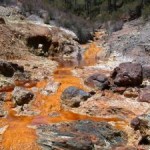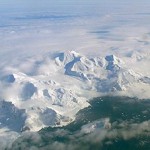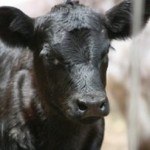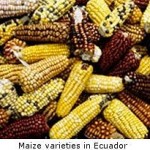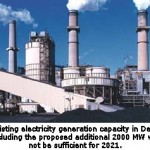A few examples have been discussed in brief as to how remote sensing and GIS provide the required information.
1. Around Super Thermal Power Stations
The establishment of super thermal power plants has brought changes in the land use/land cover and vegetation patterns. Increased anthropogenic pressure causes degradation of forest of the surrounding area. Activities associated with thermal power plants such as large coal quarrying and several ash ponds become a source of environmental concern. Using multi-data satellite images, further subjecting the data to digital change analysis, changes in land use/land cover and vegetation can be monitored. Fine resolution satellite data helps in studying structures to patch level. Coarse resolution satellite data help in giving a broad picture of the study area that is at regional scale. In conjunction with Geographic Information Systems (GIS), maps can be generated and areas of high risk can be identified. Availability of multi-resolution and multi-spectral satellite data has helped in identification and description of smaller patches, better discrimination of different vegetation cover classes; change in land use and land cover patterns and in calculating the extent and volume of ash ponds.
Using LISS III and PAN data land cover changes have been studied around Korba Super Thermal Power Plant, Korba, Madhya Pradesh. Digital Classification and spatial analysis have delineated various vegetation classes and the area covered by them. Decrease in degraded forest has been observed and increase in the case of various forest plantation areas due to good protection efforts (Jha et al, 2002).
2. Around Mining Sites
Minerals and mineral products are a major requirement for many industries. Mining has significant effect on environment and climate change; thus, affecting the existing land cover patterns resulting in loss of agriculture areas, deforestation, soil erosion and relocation of human settlements. Excavations, waste disposal and overburden are the result of mining activity. These in turn affect the natural drainage courses; thus, causing land and water pollution. Activities like blasting, transport and mine dust cause air pollution which affects the local environment, vegetation and wild life habitat. To avoid ground water contamination, it is necessary to identify suitable areas for overburden and mine waste disposal.
Multi-spectral satellite data provides information regarding vegetation and land cover. High resolution satellite data gives us information related to geology/geomorphology and terrain. Aerial extent of mining pits and overburden may also be calculated using high resolution satellite data. Using multi-temporal satellite data, change in land cover pattern may be monitored that is pre-development and post-development stages. Further, in conjunction with terrain analysis in Geographic Information System (GIS), Digital Elevation Model can help in monitoring drainage patterns. The baseline information on forest cover and biomass levels as derived from remotely sensed data is utilized by the end user agencies and departments as a vital input for analyzing the possible impacts of mining and also to assess the feasibility of mining and subsequent mine leasing. Around 90% accuracy has been achieved for studies conducted using remote sensing and GIS in various mining sites in India like Indian Bureau of Mines, Nagpur and Sanghi Cement Industry in Kutch, Gujarat.
3. In Vegetation Studies
The use of remote sensing data has been widely accepted as an important tool in qualitative and quantitative vegetation studies. It has been used successfully in biodiversity assessment, locations of hot-spots, habitat suitability, and in defining protected areas. High resolution satellite data such as IRS 1C/1D PAN, SPOT panchromatic image and IKONOS open new opportunities in forest mapping and monitoring. They are in equivalence to the aerial photographs. Medium resolution sensors such as Landsat, IRS, SPOT, MOS and Okean are useful in providing information at 1:250,000 scale. Various vegetation types can be defined, forest change caused by forest fire or shifting cultivation can be monitored. Low resolution sensors like WiFS have the capability of providing data of a very large area and, thus, can be used for regional scale studies. IRS-WiFS data was used for preparation of ecological zone maps at regional level.
Laser altimeters or light detecting and ranging (LIDAR) systems have been used to develop a profile of the forest canopy which is used to determine forest tree heights. Some air born sensors acquire data simultaneously in more than 200 spectrally narrow bands, resulting in what is called “hyper spectral remote sensing”. Hyper spectral remote sensing data provides information about surface features in very narrow spectral range; thus, minute alterations can also be mapped. Moreover, such data is useful in classifying tree stands in a forest.
The use of IRS -1C PAN and IKONOS for micro- level vegetation analysis, such as stock mapping and its updating, have an advantage over conventional in achieving more informative stock maps (Roy and Joshi 2000). IRS 1C – LISS III data was used to delineate six major vegetation types and forest plantation in Shervayan hills, Eastern Ghats, India ( Balagaru et al.,2003). Thenkabail et al., (2004) compared the abilities of hyper-spectral satellite imagery, IKONOS, and Landsat 7 ETM+ for use in quantifying and modelling the biomass of tree, shrub, and weed species, and to characterize forest land use/land cover (LULC) classes. Using IRS 1D LISS III data, spatial patterns of fragmented plant communities was studied in Tropical Forests of Vindhyan Highlands (Goparaju and Jha, 2010).

